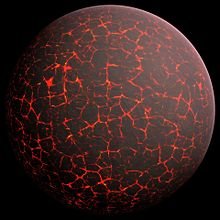History of the Earth
The age of the Earth is approximately one-third of the age of the universe. The Earth formed at roughly the same time as the sun and other planets round about 4.6 billion years ago. The atmosphere contained almost no oxygen and would be toxic to most modern life including humans. The solar wind from the sun was very powerful, it swept away most of the lighter elements, such as hydrogen and helium from the innermost worlds giving Earth and its siblings into small, rocky planets. Some 4.567 billion years ago, our solar system's planets spawned from an expensive disc of gas and dust rotating around the sun. While similar processes are witnessed in younger solar systems throughout the Milky Way, the formative stages of our own solar system were believed to have taken twice as long to occur. Over time, the Earth cooled, causing the formation of a solid crust, allowing liquid water to exist on the surface. Recent evidence suggests that Earth's crust and oceans may have formed within 200 million years after the planet had taken shape. The history of Earth is divided into four eons which are: Hadean, Archean, Proterozoic and Phanerozoic. Hadean Eon represents time before the reliable which was the fossils. Archean and Proterozoic eons produced the abiogenesis of life on Earth, then the evolution of early life. The first three eons, together lasted nearly 4 billion years, together known as Precambrian. Evidence for life was found in the Archean about 3.8 billion years ago, gut didn't become abundant until the Phanerozoic. Phanerozoic is divided into eras which are Paleozoic, Mesozoic and Cenozoic. Mesozoic era was the age of dinosaurs. Cenozoic era currently is the age of mammals. Most of the fossils seen in the Paleozoic rocks are invertebrate animals lacking backbones such as the corals, mollusks and trilobites. The earliest direct ancestors of the human clade was the hominins. There are microbial mat fossils such as stromatolites found in 3.48 billion years old sandstone discovered in Western Australia. Species continue to evolve, taking on new forms, splitting into daughter species or going extinct in the process of adapting. The process of plate tectonics continue to play a dominant role in the shaping of Earth's oceans and continents. Earth is often described as having had three atmospheres. The first atmosphere, captured from the solar nebula, was composed of atmophile elements from the solar nebula, mostly hydrogen and helium. A combination of the solar wind and Earth's heat would have driven off this atmosphere, as a result of which the atmosphere is now depleted of these elements compared to cosmic abundances. After the impact which created the moon, the molten Earth released volatile gases, and later more gases were released by volcanoes, completing a second atmosphere rich in greenhouse gases but poor in oxygen. The third atmosphere, rich in oxygen, emerged when bacteria began to produce oxygen about 2.8 Ga.
Bibliography: Science textbook and Wikipedia, the free encyclopedia.
 Mesozoic Era: Era of dinosaurs
Mesozoic Era: Era of dinosaurs
 Archean and Proterozoic Eons: Evolution
Archean and Proterozoic Eons: Evolution
 Hadean Eon: Earth's formation
Hadean Eon: Earth's formation